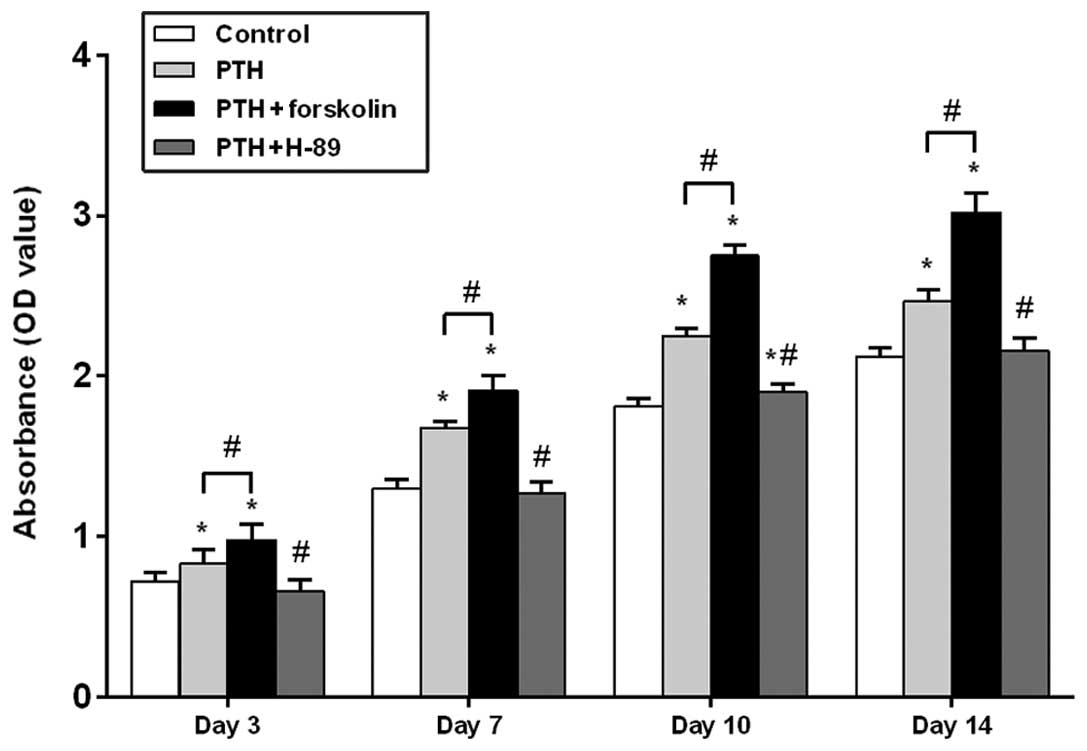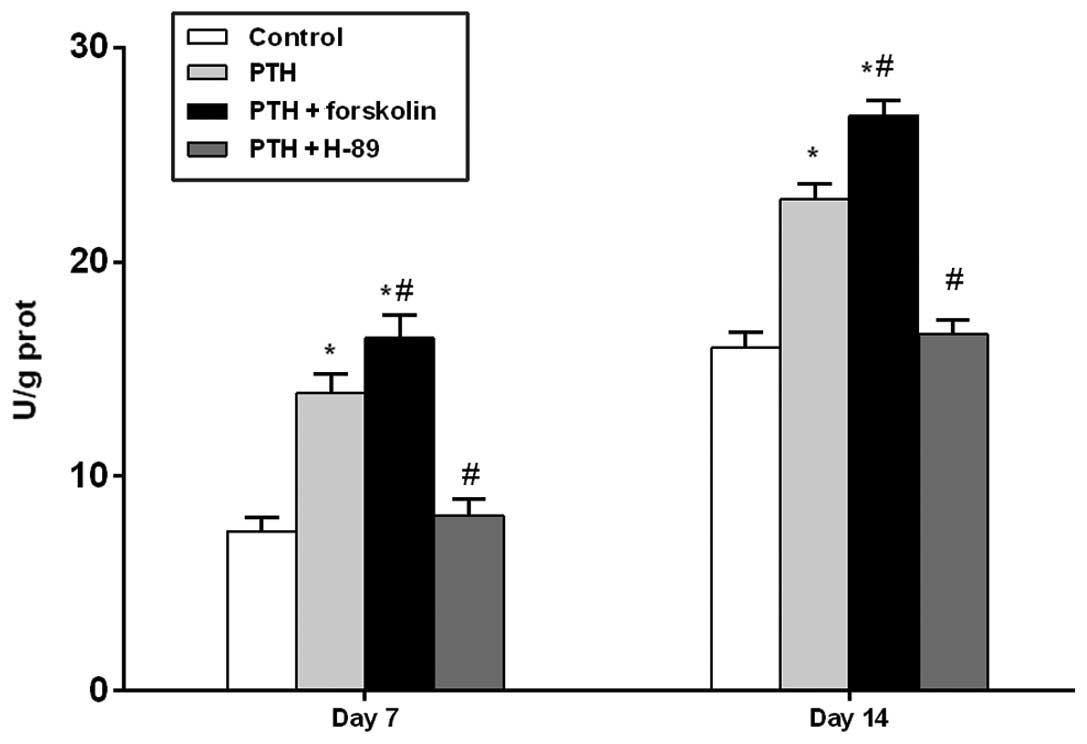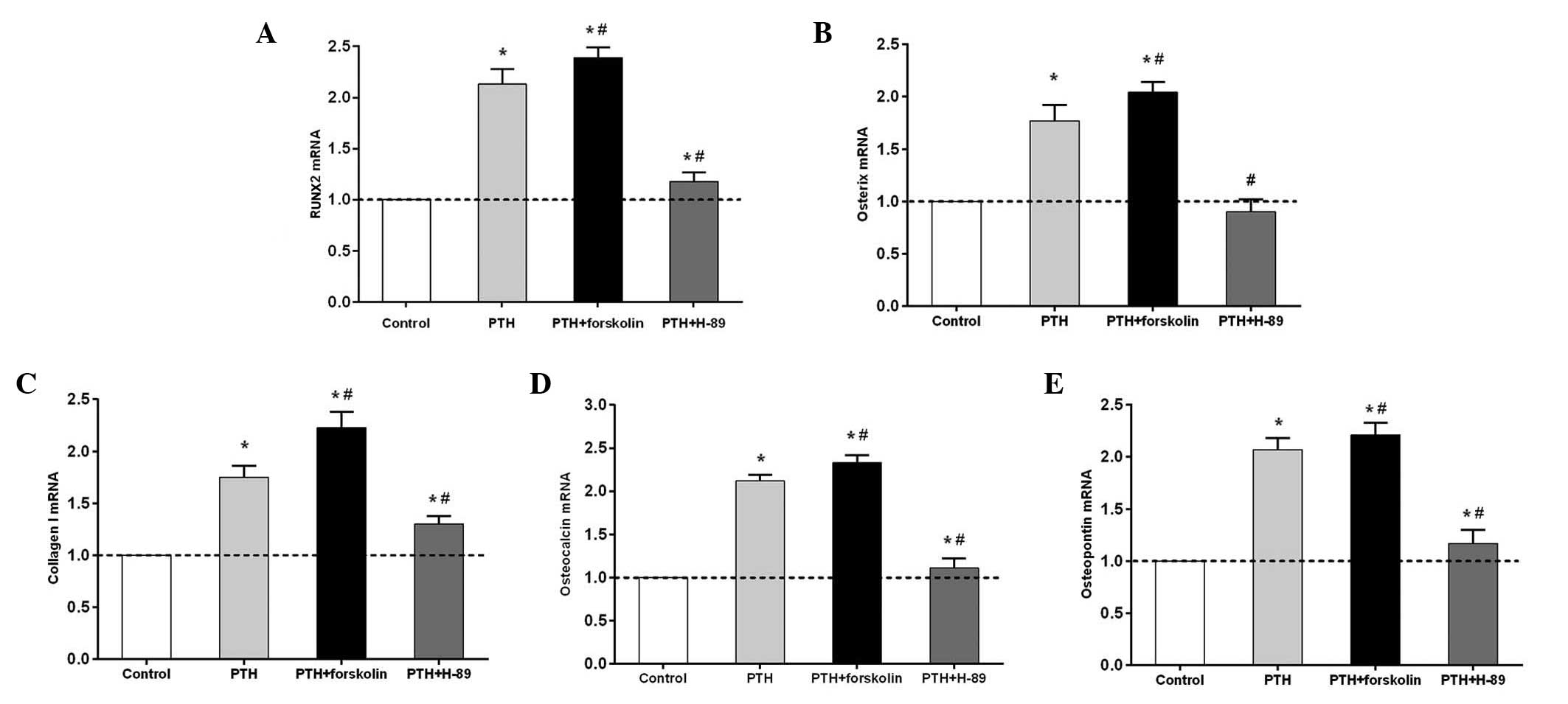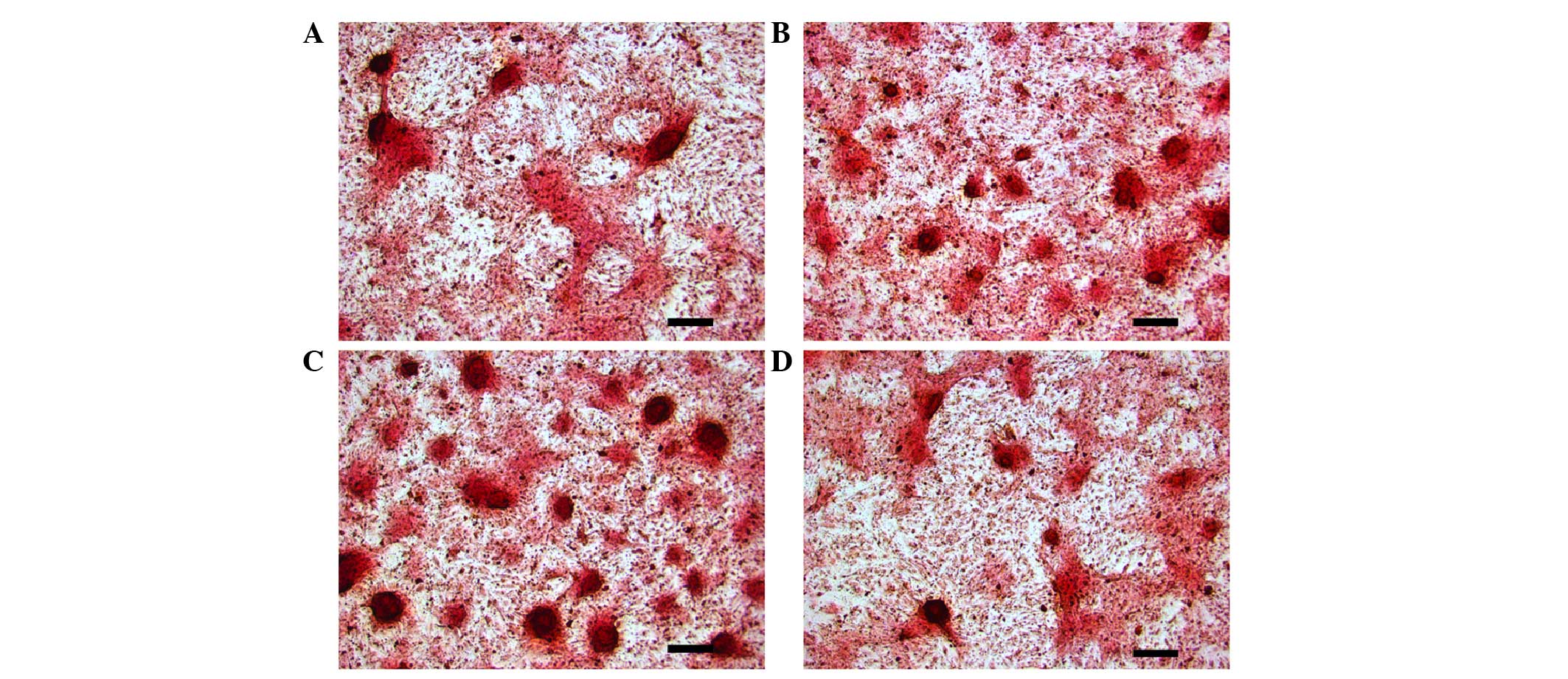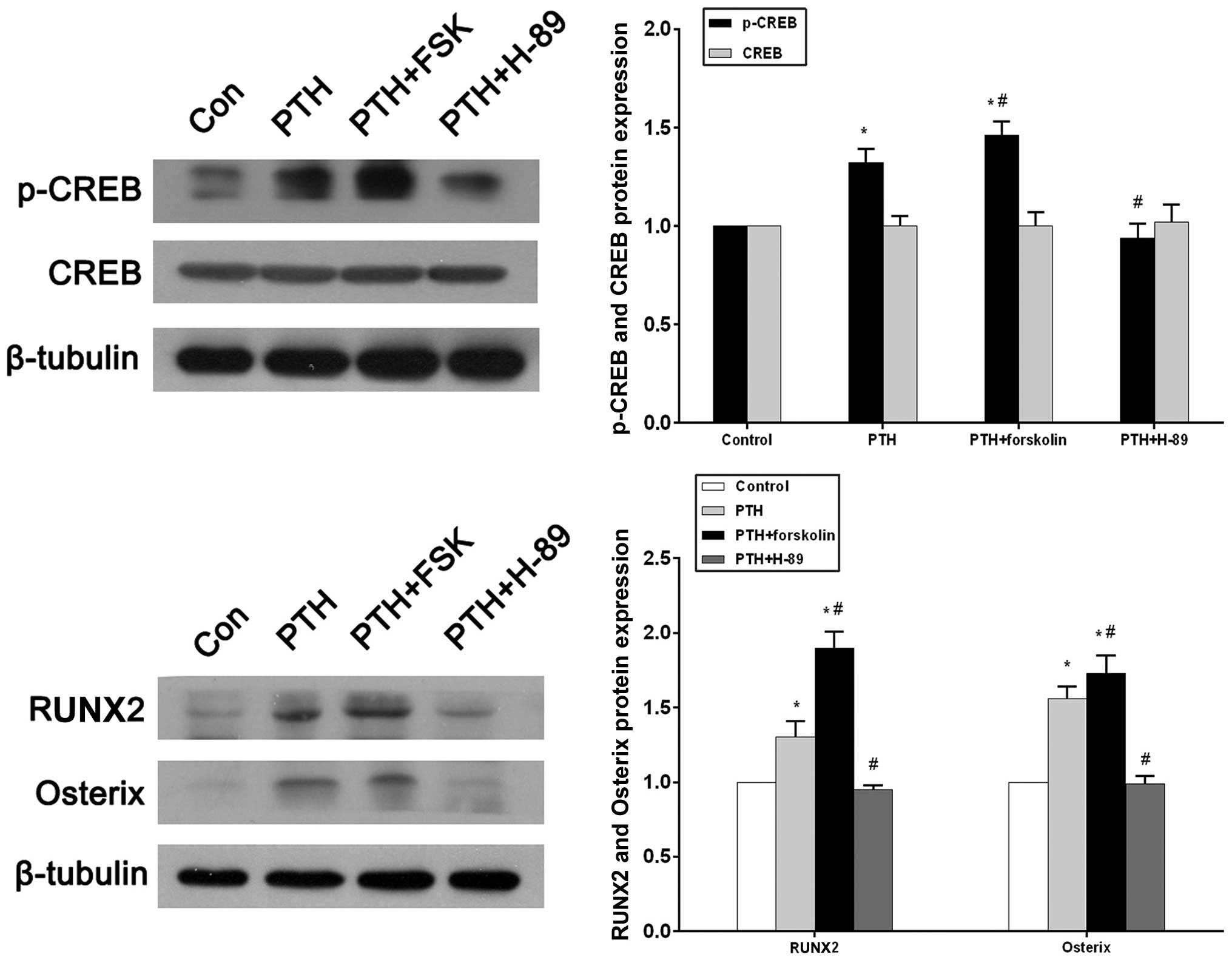|
1
|
Pettway GJ, Meganck JA, Koh AJ, Keller ET,
Goldstein SA and McCauley LK: Parathyroid hormone mediates bone
growth through the regulation of osteoblast proliferation and
differentiation. Bone. 42:806–818. 2008. View Article : Google Scholar : PubMed/NCBI
|
|
2
|
Compston JE: Skeletal actions of
intermittent parathyroid hormone: Effects on bone remodelling and
structure. Bone. 40:1447–1452. 2007. View Article : Google Scholar : PubMed/NCBI
|
|
3
|
Neer RM, Arnaud CD, Zanchetta JR, Prince
R, Gaich GA, Reginster JY, Hodsman AB, Eriksen EF, Ish-Shalom S,
Genant HK, et al: Effect of parathyroid hormone (1–34) on fractures
and bone mineral density in postmenopausal women with osteoporosis.
N Engl J Med. 344:1434–1441. 2001. View Article : Google Scholar : PubMed/NCBI
|
|
4
|
Jiang Y, Zhao J, Liao EY, Dai RC, Wu XP
and Genant HK: Application of micro-CT assessment of 3-D bone
microstructure in preclinical and clinical studies. J Bone Miner
Metab. 23(Suppl): S122–S131. 2005. View Article : Google Scholar
|
|
5
|
Jilka RL, Weinstein RS, Bellido T,
Roberson P, Parfitt AM and Manolagas SC: Increased bone formation
by prevention of osteoblast apoptosis with parathyroid hormone. J
Clin Invest. 104:439–446. 1999. View
Article : Google Scholar : PubMed/NCBI
|
|
6
|
Kaback LA, do Soung Y, Naik A, Geneau G,
Schwarz EM, Rosier RN, O'Keefe RJ and Drissi H: Teriparatide (1–34
human PTH) regulation of osterix during fracture repair. J Cell
Biochem. 105:219–226. 2008. View Article : Google Scholar : PubMed/NCBI
|
|
7
|
Yang C, Frei H, Burt HM and Rossi F:
Effects of continuous and pulsatile PTH treatments on rat bone
marrow stromal cells. Biochem Biophys Res Commun. 380:791–796.
2009. View Article : Google Scholar : PubMed/NCBI
|
|
8
|
Wang BL, Dai CL, Quan JX, Zhu ZF, Zheng F,
Zhang HX, Guo SY, Guo G, Zhang JY and Qiu MC: Parathyroid hormone
regulates osterix and Runx2 mRNA expression predominantly through
protein kinase A signaling in osteoblast-like cells. J Endocrinol
Invest. 29:101–108. 2006. View Article : Google Scholar : PubMed/NCBI
|
|
9
|
Nakao Y, Koike T, Ohta Y, Manaka T, Imai Y
and Takaoka K: Parathyroid hormone enhances bone morphogenetic
protein activity by increasing intracellular 3′,5′-cyclic adenosine
monophosphate accumulation in osteoblastic MC3T3-E1 cells. Bone.
44:872–877. 2009. View Article : Google Scholar : PubMed/NCBI
|
|
10
|
Kulkarni NH, Halladay DL, Miles RR,
Gilbert LM, Frolik CA, Galvin RJ, Martin TJ, Gillespie MT and Onyia
JE: Effects of parathyroid hormone on Wnt signaling pathway in
bone. J Cell Biochem. 95:1178–1190. 2005. View Article : Google Scholar : PubMed/NCBI
|
|
11
|
Inoue Y, Canaff L, Hendy GN, Hisa I,
Sugimoto T, Chihara K and Kaji H: Role of Smad3, acting
independently of transforming growth factor-beta, in the early
induction of Wnt-beta-catenin signaling by parathyroid hormone in
mouse osteoblastic cells. J Cell Biochem. 108:285–294. 2009.
View Article : Google Scholar : PubMed/NCBI
|
|
12
|
Tian Y, Xu Y, Fu Q and He M: Parathyroid
hormone regulates osteoblast differentiation in a
Wnt/β-catenin-dependent manner. Mol Cell Biochem. 355:211–216.
2011. View Article : Google Scholar : PubMed/NCBI
|
|
13
|
Miao D, Tong XK, Chan GK, Panda D,
McPherson PS and Goltzman D: Parathyroid hormone-related peptide
stimulates osteogenic cell proliferation through protein kinase C
activation of the Ras/mitogen-activated protein kinase signaling
pathway. J Biol Chem. 276:32204–32213. 2001. View Article : Google Scholar : PubMed/NCBI
|
|
14
|
Rey A, Manen D, Rizzoli R, Ferrari SL and
Caverzasio J: Evidences for a role of p38 MAP kinase in the
stimulation of alkaline phosphatase and matrix mineralization
induced by parathyroid hormone in osteoblastic cells. Bone.
41:59–67. 2007. View Article : Google Scholar : PubMed/NCBI
|
|
15
|
Siddappa R, Martens A, Doorn J, Leusink A,
Olivo C, Licht R, van Rijn L, Gaspar C, Fodde R, Janssen F, et al:
cAMP/PKA pathway activation in human mesenchymal stem cells in
vitro results in robust bone formation in vivo. Proc Natl Acad Sci
USA. 105:7281–7286. 2008. View Article : Google Scholar : PubMed/NCBI
|
|
16
|
Kao R, Lu W, Louie A and Nissenson R:
Cyclic AMP signaling in bone marrow stromal cells has reciprocal
effects on the ability of mesenchymal stem cells to differentiate
into mature osteoblasts versus mature adipocytes. Endocrine.
42:622–636. 2012. View Article : Google Scholar : PubMed/NCBI
|
|
17
|
Doorn J, Siddappa R, van Blitterswijk CA
and de Boer J: Forskolin enhances in vivo bone formation by human
mesenchymal stromal cells. Tissue Eng Part A. 18:558–567. 2012.
View Article : Google Scholar : PubMed/NCBI
|
|
18
|
Yang DC, Tsay HJ, Lin SY, Chiou SH, Li MJ,
Chang TJ and Hung SC: cAMP/PKA regulates osteogenesis, adipogenesis
and ratio of RANKL/OPG mRNA expression in mesenchymal stem cells by
suppressing leptin. PLoS One. 3:e15402008. View Article : Google Scholar : PubMed/NCBI
|
|
19
|
Potts JT: Parathyroid hormone: Past and
present. J Endocrinol. 187:311–325. 2005. View Article : Google Scholar : PubMed/NCBI
|
|
20
|
Zimmermann M: Ethical guidelines for
investigations of experimental pain in conscious animals. Pain.
16:109–110. 1983. View Article : Google Scholar : PubMed/NCBI
|
|
21
|
Kawane T, Mimura J, Yanagawa T,
Fujii-Kuriyama Y and Horiuchi N: Parathyroid hormone (PTH)
down-regulates PTH/PTH-related protein receptor gene expression in
UMR-106 osteoblast-like cells via a 3′,5′-cyclic adenosine
monophosphate-dependent, protein kinase A-independent pathway. J
Endocrinol. 178:247–256. 2003. View Article : Google Scholar : PubMed/NCBI
|
|
22
|
Livak KJ and Schmittgen TD: Analysis of
relative gene expression data using real-time quantitative PCR and
the 2(−Delta Delta C(T)) Method. Methods. 25:402–408. 2001.
View Article : Google Scholar : PubMed/NCBI
|
|
23
|
Nozaka K, Miyakoshi N, Kasukawa Y, Maekawa
S, Noguchi H and Shimada Y: Intermittent administration of human
parathyroid hormone enhances bone formation and union at the site
of cancellous bone osteotomy in normal and ovariectomized rats.
Bone. 42:90–97. 2008. View Article : Google Scholar : PubMed/NCBI
|
|
24
|
Rickard DJ, Wang FL, Rodriguez-Rojas AM,
Wu Z, Trice WJ, Hoffman SJ, Votta B, Stroup GB, Kumar S and Nuttall
ME: Intermittent treatment with parathyroid hormone (PTH) as well
as a non-peptide small molecule agonist of the PTH1 receptor
inhibits adipocyte differentiation in human bone marrow stromal
cells. Bone. 39:1361–1372. 2006. View Article : Google Scholar : PubMed/NCBI
|
|
25
|
Baron R and Hesse E: Update on bone
anabolics in osteoporosis treatment: Rationale, current status, and
perspectives. J Clin Endocrinol Metab. 97:311–325. 2012. View Article : Google Scholar : PubMed/NCBI
|
|
26
|
Nishida S, Yamaguchi A, Tanizawa T, Endo
N, Mashiba T, Uchiyama Y, Suda T, Yoshiki S and Takahashi HE:
Increased bone formation by intermittent parathyroid hormone
administration is due to the stimulation of proliferation and
differentiation of osteoprogenitor cells in bone marrow. Bone.
15:717–723. 1994. View Article : Google Scholar : PubMed/NCBI
|
|
27
|
Nakashima K and de Crombrugghe B:
Transcriptional mechanisms in osteoblast differentiation and bone
formation. Trends Genet. 19:458–466. 2003. View Article : Google Scholar : PubMed/NCBI
|
|
28
|
Marie PJ: Transcription factors
controlling osteoblastogenesis. Arch Biochem Biophys. 473:98–105.
2008. View Article : Google Scholar : PubMed/NCBI
|
|
29
|
Krishnan V, Moore TL, Ma YL, Helvering LM,
Frolik CA, Valasek KM, Ducy P and Geiser AG: Parathyroid hormone
bone anabolic action requires Cbfa1/Runx2-dependent signaling. Mol
Endocrinol. 17:423–435. 2003. View Article : Google Scholar : PubMed/NCBI
|
|
30
|
Stucki U, Schmid J, Hämmerle CF and Lang
NP: Temporal and local appearance of alkaline phosphatase activity
in early stages of guided bone regeneration. A descriptive
histochemical study in humans. Clin Oral Implants Res. 12:121–127.
2001. View Article : Google Scholar : PubMed/NCBI
|
|
31
|
Franceschi RT: The developmental control
of osteoblast-specific gene expression: Role of specific
transcription factors and the extracellular matrix environment.
Crit Rev Oral Biol Med. 10:40–57. 1999. View Article : Google Scholar : PubMed/NCBI
|
|
32
|
Zhou Y, Guan X, Zhu Z, Gao S, Zhang C, Li
C, Zhou K, Hou W and Yu H: Osteogenic differentiation of bone
marrow-derived mesenchymal stromal cells on bone-derived scaffolds:
Effect of microvibration and role of ERK1/2 activation. Eur Cell
Mater. 22:12–25. 2011.PubMed/NCBI
|
|
33
|
Zhang C, Li J, Zhang L, Zhou Y, Hou W,
Quan H, Li X, Chen Y and Yu H: Effects of mechanical vibration on
proliferation and osteogenic differentiation of human periodontal
ligament stem cells. Arch Oral Biol. 57:1395–1407. 2012. View Article : Google Scholar : PubMed/NCBI
|
|
34
|
Owen TA, Aronow M, Shalhoub V, Barone LM,
Wilming L, Tassinari MS, Kennedy MB, Pockwinse S, Lian JB and Stein
GS: Progressive development of the rat osteoblast phenotype in
vitro: Reciprocal relationships in expression of genes associated
with osteoblast proliferation and differentiation during formation
of the bone extracellular matrix. J Cell Physiol. 143:420–430.
1990. View Article : Google Scholar : PubMed/NCBI
|
|
35
|
Bourtchuladze R, Frenguelli B, Blendy J,
Cioffi D, Schutz G and Silva AJ: Deficient long-term memory in mice
with a targeted mutation of the cAMP-responsive element-binding
protein. Cell. 79:59–68. 1994. View Article : Google Scholar : PubMed/NCBI
|
|
36
|
Tyson DR, Swarthout JT and Partridge NC:
Increased osteoblastic c-fos expression by parathyroid hormone
requires protein kinase A phosphorylation of the cyclic adenosine
3′,5′-monophosphate response element-binding protein at serine 133.
Endocrinology. 140:1255–1261. 1999. View Article : Google Scholar : PubMed/NCBI
|



